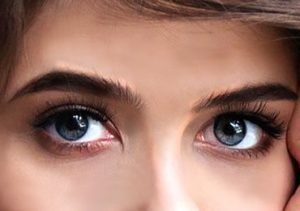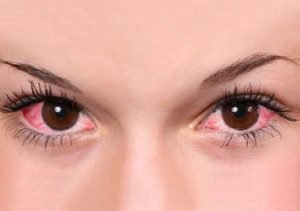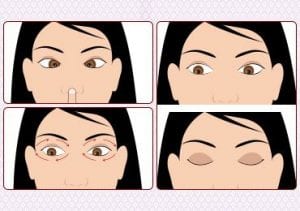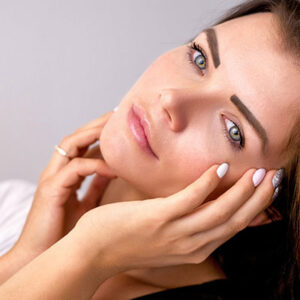Some fun facts you didn’t know about the eyes
- An average blink for any eye would last for about 1/10th of the second
- It takes merely 48 hours for the eyes to heal a corneal scratch
- Visualizing is such an activity which involves nearly half of your brain
- Newborn babies don’t produce tears. They make a crying sound but tears appear rolling their eyes when they are around 4 to 13 weeks old
- Everyone normally blinks their eyes for around 12 times in a minute
- Heterochromia is a condition where the sufferer is born with two different eye color shades
- Around 55% of the total population on the earth comes with brown colored eyes
- The cornea is a transparent cover for the pupil and the iris which protects the eyes from any kind of germ and dirt
- 20/20 vision basically means you are having a normal eyesight
- During pregnancy when the women are experiencing physical and hormonal changes, it is possible that she might face problems with her sight
Poor Eyesight – An Introduction
Poor eyesight or poor vision is basically the loss of sharpness in the eyesight which makes the objects appear to blur, hazy, or out of focus. The primary causes of such eyesight are some refractive errors which include presbyopia, astigmatism, farsightedness, and nearsightedness. Poor eyesight is also a symptom of some serious health issues like neurological disorders, sight-threatening diseases, etc. Poor eyesight is an issue that impacts either one or both the eyes.
Poor eyesight is often mistaken with cloudy vision in which the things appear milky and are obscured. But this can only be determined by the doctor whether one is suffering from blurred vision or cloudy vision with the help of an eye examination that includes standard Snellen eye chart tests, slit-lamp, and spatial contrast sensitivity.
What are the possible reasons for having poor eyesight?
No matter whether you are simply using glasses for a clear vision and reading, or wearing contact lenses on a regular basis, poor eyesight is not a condition that affects similar to other normal eye issues. There are particular reasons you might be suffering from this issue which includes :
1. Myopia
Also known as nearsightedness, poor eyesight is a symptom that can accompany other issues like headaches, eye strain, and squinting. It is among the common refractive errors and can lead to blurring of the objects at distance. Some of the popular ways of fixing myopia are contact lenses, eyeglasses, PRK surgery, LASIK surgery, etc. for correcting nearsightedness.
Here are some effective home remedies for Eye Stye.
2. Hyperopia
Hyperopia is popularly known as farsightedness in which the distant objects can sharply be seen but the eyes are not able to focus on the objects, or doing which can result in fatigue and eye strain. If the case is severe, the objects can appear blur also. Similar to myopia, the treatment of hyperopia is contact lenses, eyeglasses, or any kind of refractive eye surgery.
3. Astigmatism
Astigmatism is another refractive eye disorder that individuals can experience the ill effects of. For the most part, this condition results from unpredictably formed corneas. On the off chance that you have astigmatism, light beams won’t go to a solitary spotlight point on your retina. So regardless of how close or far away a thing is, you can’t see it plainly. Beside obscured vision, you may likewise encounter migraines and dry or consuming eyes.
4. Presbyopia
Presbyopia is a type of farsightedness that happens normally as you age. You may see indications once you turn 40. Manifestations of this condition are equivalent to hyperopia; however, you will likewise make some harder memories concentrating on close-up objects. This powerlessness to center outcomes from the solidifying of the focal point inside your eye as opposed to from issues with the retina. Regularly, perusing glasses can treat the condition.
5. Glaucoma
This among the most common reasons leading to poor eyesight. Glaucoma is where the liquid in your eye can’t deplete typically. This liquid develops, expanding the weight in your eye. which can squeeze or harm the optic nerve. Thus, you can’t see as unmistakably, and you could go daze without the best possible treatment. Two sorts of glaucoma exist point conclusion and open-edge. With edge conclusion glaucoma, the seepage channels in your eye are totally blocked. What’s more, in open-glaucoma, the optic nerve becomes harmed gradually and easily.
Apart from all these, some other reasons leading to blurred or poor eyesight include over-wearing of lenses, medications, eye drops, LASIK treatment, eye floaters, migraine, ocular migraine, pregnancy, and even chronic dry eyes.
What are the symptoms of poor eyesight?
There are some symptoms connected with poor eyesight. Some can be mild while some can turn out to be serious if not looked after. The list of the symptoms includes:
1. Eye diseases
On the off chance that you have an unexpected foggy vision in one eye and are more than 60 years age, you may have built up a macular gap in the piece of the retina where fine centering happens. Hazy vision additionally might be a manifestation of a disconnected retina, eye herpes or optic neuritis that is, aggravation of the optic nerve, among different causes. A portion of these eye maladies can prompt changeless vision misfortune and subsequently, one should consider treatment at the earliest opportunity.
2. Cataracts
Vision changes, like obscured vision or shady vision, just as glares and night coronas, might be manifestations of a waterfall. On the off chance that unremoved waterfalls can inevitably develop so shady that they discourage vision to the point of visual impairment. However, by supplanting waterfalls with fake focal points, the waterfall medical procedure is exceptionally fruitful in reestablishing lost vision.
3. Macular degeneration due to age
A slow misfortune and obscuring of vision, including twists, for example, straight lines seeming wavy or broken, could be manifestations of age-related macular degeneration (AMD), the main source of visual impairment among more seasoned individuals.
4. Cardiovascular and systemic issues
Poor vision, regularly related to twofold vision, can be a side effect of a basic wellbeing crisis, for example, a stroke or mind drain; or it tends to be an early indication of different sclerosis. On the off chance that you have an abrupt hazy vision or twofold vision, see your primary care physician right away.
5. Diabetic Retinopathy
On the off chance that you have diabetes, unexplained obscured vision might be because of the beginning of diabetic retinopathy, a sight-compromising ailment that harms the retina of the eye.
If you are suffering from minor poor eye sightedness which arrives and goes, this can also be due to tiredness, eye strain, or overexposure to the sunlight. But if continuous or sudden changes are observed, it can also lead to blind spots, tunnel vision, dimness, halos, double vision, or any other serious health or eye issues.
How can poor visual be diagnosed?
An eye test by your eye care pro can analyze low vision. You should make a meeting with your eye specialist if your vision troubles are keeping you from day by day exercises like travel, cooking, work, and school. The tests the eye specialist will perform incorporate the utilization of lighting, magnifiers, and uncommon graphs to help test visual keenness, profundity discernment, and visual field.
1. What is the treatment for poor eyesight and preventions?
When it comes to the treatment of poor eyesight, there are particular disorders that can be treated which includes diabetic retinopathy. If the treatment is not possible the sufferer might have to deal with the eye issue permanently.
Some of the popular treatments for poor vision include:
- Contact lenses which filter light
- Telescopic glasses
- Hand magnifiers
- Magnifying glasses
- Reading prisms
- Closed-circuit television
Again, for the patients who are suffering from retinitis pigmentosa, are also treated with Argus II Retinal Prosthesis. With this treatment, it becomes possible to restore the vision of the patients who have lost it. In certain patients the reestablished vision considers them to freely explore through entryways, walkways, sort light, and dull shaded clothing, or even read enormous letters.
Apart from all these, there are some non-optical ways of treating poor vision which is also helpful like:
- checking guides
- software for text reading
- watches and clocks with high contrast
- publications with large prints
- clocks and watches that talk
- watches, phones, and clocks with enlarging fonts
Poor eyesight is an issue that can be well treated in the initial stage to avoid serious conditions. Again, in the initial period, it is also possible to prevent its growth. Low vision might be preventable for patients with diabetes, and a few patients with macular degeneration and glaucoma might be blessed to receive forestall the further vision misfortune.
What exercises and yoga can be carried out for healthy eyes?
There are many Yoga Asanas that are helpful for improving the organ functioning which includes the eyes also. There are some exercises too which are much effective on long as well as short or poor eyesight.
Some of the Yoga Asanas for healthy eyes that give effective results include:
1. Blinking
This exercise can be repeated around 4 to 5 times a day as it would help in preventing the eye from the strain. Here is how to do the exercise.
- Sit at a place with comfort keeping your eyes open
- Blink the eyes 10 times quickly
- Close the eyes after 10 blinks and relax for around 20 seconds
- While closing the eyes, focus on your breath
Blinking and relaxing the eyes would provide the eyes with comfort and improve the vision too.
2. Palming
Palming provides the eyes with some natural warmth with the help of the hands. Here is how you can do the Asana.
- Sit with comfort and close the eyes
- Take some deep breaths and relax yourself
- Rub your hands, particularly the palms roughly till you feel them warm
- Place the warm palms on the eyes and feel the warmth getting transferred to the eyes and the muscles
- Keep your hands on the eyes till the warmth is felt
Repeat this process for around 3 times in a day for providing the eyes with some natural care and relaxation.
3. Front and Side Views
This exercise helps the eyes in reducing the stress levels. For doing the exercise, here is what you have to do:
- Sit on a chair or stool with your feet in the front side of the body
- Now firstly, close the fist of the left side placing it on the left knee such that the thumb points in the upward direction
- Keep the head proper in the same position
- Focus your eyes on the left thumb while you breathe out
- Focus on a point in the front direction with a level of your eyes while you breathe in
- Now repeat the same way with the right fist and thumb
When the exercise is over, close the eyes and rest for some seconds.
4. Near and far viewing
This exercise is the best for people who have long working hours on computers and laptops. For doing this exercise:
- Stand or sit at a window side and open it. Keep the arms on the side
- Firstly, focus the sight on the nose tip for around 5 to 10 seconds
- Then focus on something outside the window for 5 to 10 seconds
- Repeat this for 10 to 20 times
- Close the eyes and allow it to rest
While inhaling, make sure you have a close focus, and at the time of exhaling a distant focus.
Apart from all these, other exercises that help in improving the poor eyesight or help in maintaining the health of the eyes include Sarvangna Asana, Bhramari Pranayam, Preliminary nose tip gazing, up and down viewing, rotational viewing, sideways viewing, and much more.
What is the best diet for healthy eyesight?
There are many people who believe having the right food can help in fixing the issues with eyesight. This is true! Having food items that are rich in nutrients like lutein, zeaxanthin, omega-3 fatty acids, beta carotene, Vitamin C, zinc, Vitamin E, and copper is surely going to help you improve and maintain the health of the eyes.
Here are some of the ingredients that should be included in your diet when looking for working on the eyesight.
1. Fish
There are many fishes that are rich in Omega-3 fatty acids. The fishes contain oil in their body tissues and gut and hence, having them in the diet help in boosting the Omega-3s in the body. Some types of fishes you can look for good eyesight include salmon, tuna, mackerel, trout, anchovies, sardines, and herring. Again, having fish oil in the diet can also be helpful for dry eyes which is basically caused due to working for long hours on computers.
2. Legumes and nuts
Legumes and nuts are filled with Omega-3 fatty acids along with Vitamin E that are helpful in protecting the eyes from any kind of damages. They are good for the health of the eyes. For obtaining all the benefits, look for nuts and legumes like Brazil nuts, walnuts, peanuts, cashews, and lentils and make your dishes much healthy for your eyes.
3. Seeds
Apart from the legumes and nuts, the seeds are also rich in Vitamin E and Omega-3 fatty acids. Including them in your diet is sure to add to your nutrient levels and help in improving the health of the eyes. Seeds in the list are easily available in your groceries which include flax seeds, hemp seeds, sunflower seeds, and chia seeds.
4. Citrus fruits
Some citrus fruits also hold a vital role in improving the health of the eyes. They are rich in Vitamin E and C which play the role of an antioxidant which is quite essential for preventing any kind of damages to the eyes due to aging. The fruits in the list are grapefruits, oranges, and lemons.
5. Green leafy vegetables
Just as green leafy veggies are essential for other health issues, they are quite effective in having healthy eyes too. They are rich in zeaxanthin, lutein, and Vitamin C which are quite effective in keeping spectacles away for a long time. Some of the green leafy veggies in the list are kale, collards, spinach, etc.
6. Carrots
Popular among all, carrots are filled with beta carotene and Vitamin A which are quite essential for the eyes. Vitamin A obtained from the carrots, also known as rhodopsin is helpful for the retina for absorbing the light. Secondly, beta carotene is helpful for the body for producing Vitamin A. So, add carrots to your diet through salads, juices, etc. and help your eyes grow healthy.
Apart from all these, some other ingredients that are helpful for healthy eyes are raw red peppers, cauliflower, strawberries, papayas, bok choy, beef, sweet potatoes, eggs, lean meat, beans, squash, Brussels sprouts, Broccoli, etc. Also, keeping yourself hydrated throughout the day to avoid dehydration is another way of keeping your eyes healthy.
What are the different ways of adapting to poor eyesight?
Apart from meditations, exercises and treatments, there are some simple changes that can help you adapt to poor eyesight. Here are some key ways to do adapt.
1. Make some changes at home
Make a list of the things that are troubling you at your home. Look for some accommodations that would help in managing the daily household chores. Make sure you are taking care of all your personal requirements. Go for some low-vision aids along with other adaptive technologies like lenses, to enhance the life of your remaining vision.
2. Use proper lighting
To have a clear and safe vision at home, look for the proper positioning of the lights. This would help in seeing things that are aimed at a proper distance. Place floor lamps and tables where required, use coverings for the windows to help you adjust the lights from outside, keep lights on entries and stairways, etc.
3. Go for contrast
Decorating the house, in contrast, helps the eyes in characterizing various objects and the surroundings with ease with the help of the colors and the brightening. So, look for dark objects on the walls with light colors like switchboards. This would make it easy to identify. In this way, you can use contrast colors for electrical outlets, thermostats, oven dials, door frames, bathrooms, etc.
4. Labeling and marking
Labeling and marking are much effective for proper visuals for the people suffering from poor eyesight. Using different colorful labels for different purposes like medicines, food items, spices, and other signs can make working in the house easy. Going for dark shade marking in the bathroom, near the stairways, sinks, bathtubs, etc. through waterproof tapes or markers is also another way to protect yourself from any unwanted situation.
5. Maintain the marks well
Once the marking is carried out, the next step is to maintain all the precautions you have carried in the house. Look for torn carpets or floor coverings and remove them immediately. Don’t go for smooth coverings for the floor, especially for the bathroom and kitchen floors. Eliminate the electrical codes from walking areas, arrange the furniture and chairs properly, keep the doors of rooms either completely open or closed but not half-open, install a handrail at the stairways, etc.
Apart from all these, looking for bigger fonts for your cellphones, using talking blood-sugar meters or food scales, adaptive appliances, etc. is also another way of adapting to poor eyesight. Looking for support whenever required and staying active is also important.
Frequently Asked Questions About Eye Care
1. What are the causes of poor eyesight?
Basically, as you age, the chances of developing particular conditions like macular degeneration, cataracts, glaucoma, etc. increase. Failing to get into particular treatment for such issues can lead to poor eyesight. Some other common causes are the traumatic brain, eye injuries, uncorrected refractive errors, and congenital vision issues.
2. How does poor eyesight affect your life?
Due to poor eyesight, people may not be able to visualize either near objects or distant ones. This can lead to faulty contrast, sluggish visual reflexes, depth perception issues, etc. which can have a negative impact on the quality of your life.
3. Can work on a computer for long hours hurt the eyes?
Yes. Computers emit the levels of radiation which are quite lower than the ones that are safe for the eyes. Hence, working for long hours on computers can lead to various issues regarding eyes like poor eyesight, blurred visions, dry eyes, etc.
Conclusion
Henceforth, if you are observing any changes in visualizing the objects, be it far or near, it is the right time to see your doctor today. Again, if you are having any other issues like headaches, a problem in seeing distant objects, reading books, etc. you should see your doctor soon. So, eat healthily, and visit your doctor for regular eye checkups to avoid any disturbing situation immediately.


















As part of your healthy diet, choose foods rich in antioxidants, like Vitamins A and C; foods like leafy, green vegetables and fish. Many foods – especially fatty fish, such as salmon – contain essential omega-3 fatty acids that are important to the health of the macula, the part of the eye responsible for central vision.